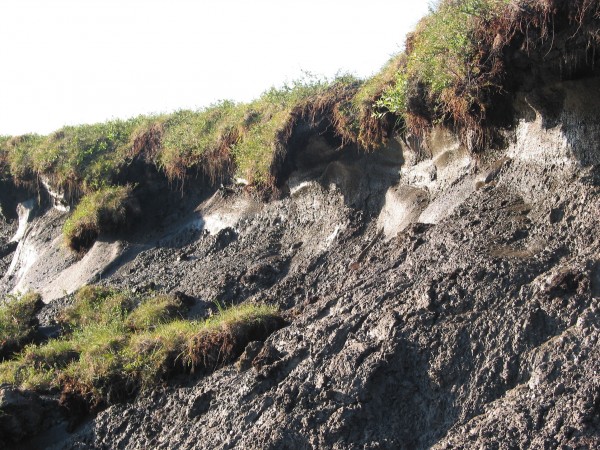Researchers Clarify Impact of Permafrost Thaw

Degrading permafrost with frozen permafrost carbon and ice wedges near Noatak, Alaska. Photo by Ted Schuur
An estimated 1,330 billion to 1,580 billion tons of organic carbon are stored in permafrost soils of Arctic and subarctic regions with the potential for even higher quantities stored deep in the frozen soil.
The carbon is made up of plant and animal remnants stored in soil for thousands of years. Thawing and decomposition by microbes cause the release of carbon dioxide and methane greenhouse gases into the atmosphere.
“Our big question is how much, how fast and in what form will this carbon come out,” said Ted Schuur, Northern Arizona University biology professor and lead author on a paper published in Nature.
The rate of carbon release can directly affect how fast climate change happens.
Schuur and fellow researchers coalesced new studies to conclude that thawing permafrost in the Artic and sub-Arctic regions will likely produce a gradual and prolonged release of substantial quantities of greenhouse gases spanning decades as opposed to an abrupt release in a decade or less.
Modern climate change is often attributed to human activities as a result of fossil fuel burning and deforestation, but natural ecosystems also play a role in the global carbon cycle.
“Human activities might start something in motion by releasing carbon gases but natural systems, even in remote places like the Arctic, may add to this problem of climate change,” Schuur said. During the past 30 years, temperatures in the Arctic have increased twice as fast as other parts of the planet.
Schuur and his team of researchers from around the world also present next steps for improving knowledge of permafrost carbon and how the dynamics will affect the global carbon cycle.
Approaches include improving climate change models by integrating newly created databases, changing models to differentiate between carbon and methane emissions and improved observations of carbon release from the landscape as the Arctic continues to warm.
Contact Information
Theresa Bierer
Public Affairs Coordinator
Theresa.Bierer@nau.edu
Phone: 928-523-9495
Mobile: 928-699-2824
Media Contact
More Information:
http://www.nau.eduAll latest news from the category: Earth Sciences
Earth Sciences (also referred to as Geosciences), which deals with basic issues surrounding our planet, plays a vital role in the area of energy and raw materials supply.
Earth Sciences comprises subjects such as geology, geography, geological informatics, paleontology, mineralogy, petrography, crystallography, geophysics, geodesy, glaciology, cartography, photogrammetry, meteorology and seismology, early-warning systems, earthquake research and polar research.
Newest articles

A universal framework for spatial biology
SpatialData is a freely accessible tool to unify and integrate data from different omics technologies accounting for spatial information, which can provide holistic insights into health and disease. Biological processes…

How complex biological processes arise
A $20 million grant from the U.S. National Science Foundation (NSF) will support the establishment and operation of the National Synthesis Center for Emergence in the Molecular and Cellular Sciences (NCEMS) at…

Airborne single-photon lidar system achieves high-resolution 3D imaging
Compact, low-power system opens doors for photon-efficient drone and satellite-based environmental monitoring and mapping. Researchers have developed a compact and lightweight single-photon airborne lidar system that can acquire high-resolution 3D…





















